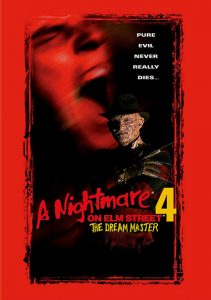A Nightmare on Elm Street 4: The Dream Master-1988
Director Renny Harlin
Starring Robert Englund, Tuesday Knight, Lisa Wilcox
Scott’s Review #1,030
Reviewed June 8, 2020
Grade: B-
By 1988, a tepid year in cinema, and with the slasher genre nearly dead on arrival, the release of A Nightmare on Elm Street 4: The Dream Master (1988) had the cards stacked against it.
The franchise feels tired and out of gas by this point, so more comedy and humorous lines were added along with a return to a similar concept offered in A Nightmare on Elm Street 3: Dream Warriors (1987), the dream sequences.
The film is so-so with not much making it stand out as compared to the superior first three offerings. Thankfully, Robert Englund is the mainstay and main attraction.
A year after the events of the previous film, Kristen (Tuesday Knight) and her friends have been released from the stifling Westin Hills sanitarium, putting the horrific events behind them.
Their attempts to resume normal teenage activities like attending class and partying are thwarted by Freddy Krueger (Englund) who begins to infiltrate Kristen’s dreams.
As usual, a fresh batch of teenagers is along for the ride as they struggle to stay awake by watching Music Television (MTV) and revisiting the lavish junkyard featured in the previous installment.
The redundancy of another franchise film using the tired “one year later” to begin events anew is feeling like a cliché.
The main character Kristen being played by a different actress does not help the film only making it lack any consistency, the fact that actress Patricia Arquette had little interest in returning for around two in the role is not the film’s fault, but a brand-new character instead of a recast might not have been a bad idea.
Recasting prominent roles may work in daytime soap operas but not in the movies.
A Nightmare on Elm Street 4: The Dream Master, while quite similar to its predecessor, Dream Warriors, so much so that they could easily be watched in tandem, has some positive qualities.
I love the MTV angle, the network music channel overtaking nearly every United States teenager’s living room or bedroom throughout the 1980s.
If the filmmakers wanted to get teenagers who might not necessarily watch horror films, this was a perfect marketing tool. The target audience is perfectly aligned, and the film feels fresh and relevant for its time of release.
The drawback to the above point is that making a film that is timely means that decades later its risk is being referred to as “of its time”, and sadly that is what has happened with Dream Master.
Nobody will scramble to watch this installment when other better chapters are out there. There may hardly be a reason to watch this one against you unless a Nightmare marathon is on the docket.
The junkyard set and the creepy church set are very good, so the film does well from a visual perspective.
Englund is Freddy and his familiarity cannot be dismissed, but the actor seems to be phoning in his performance by this point in the franchise. Finally receiving top billing, as he should, he shares his familiar witty remarks and playfully taunts his victims like a cat would before pouncing on a mouse.
The actor adds even more humor to his one-liners, but this sacrifices the horrific moments of which there are not many. A successful horror/comedy fusion is a delicate balance and there is not enough meat on the bone.
Entertaining at best, A Nightmare on Elm Street 4: The Dream Master (1988) is not well remembered, nor should it be. A dated affair, with emotionless teenage actors needing acting lessons and surely never to be heard from again, round out the cast led by Robert Englund.
The film is a letdown because it is too much like Dream Warrior and suffers from too much predictability.
